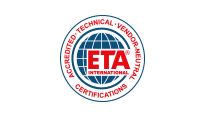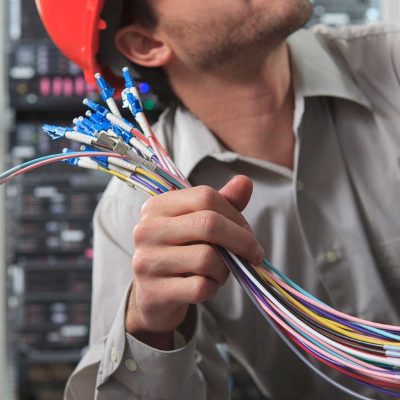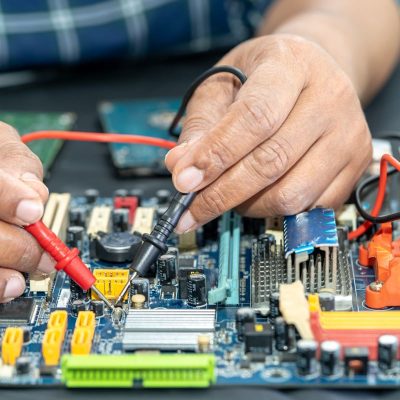Description
5G Technician (5GT)
The 5G Technician standalone certification is aimed at cellular technicians and engineers with knowledge of the wireless industry. The certification serves as an introduction to 5th Generation (5G) communications technologies and gives cellular technicians the opportunity to earn a certification that has valuable industry application. 5G Technician competencies will give first-hand looks at industry standards, real world examples and case studies provided by a committee of subject matter experts with backgrounds in engineering, construction, cell carriers, broadcasting and entertainment.
In preparation for the ETA® International 5GT certification written examination, which covers a variety of topics, 5G Technicians are expected to learn: 5G industry terminology, uses of 5G (enterprise, consumers and government systems), 5G equipment upgrading specifications, 5G networks, 5G construction best practices, 5G Standards, 5G infrastructure design and general design thinking principles and concepts.
Certified Satellite Installer (CSI)
The exams cover a broad range of hardware and broadcast technology, but are not limited to specific brands of products. The CSI covers: satellite communications history & theory, satellite dish reflectors, cabling, amplifiers, satellite dish feed-horns—LNBs & LNBFs, Satellite System Installation-site surveys, satellite receivers-digital technology, interfacing with other consumer electronics equipment, transmission-internet systems, troubleshooting, repairs, sun outage, and safety. Four endorsements are also available. Antenna (CSI-A)—roof top antennas, towers, and rotors. C and Ku Band (CSI-C/Ku)—aiming, installation and troubleshooting of large-dish systems. Commercial (CSI-COM)—VSAT and other commercial satellite systems including internet two-way units. S-MATV (CSI-SMATV)—satellite antenna signal distribution systems for multiple unit dwellings including cable-type headends.
Distributed Antenna Systems (DAS)
The exams cover a broad range of hardware and broadcast technology, but are not limited to specific brands of products. The CSI covers: satellite communications history & theory, satellite dish reflectors, cabling, amplifiers, satellite dish feed-horns—LNBs & LNBFs, Satellite System Installation-site surveys, satellite receivers-digital technology, interfacing with other consumer electronics equipment, transmission-internet systems, troubleshooting, repairs, sun outage, and safety. Four endorsements are also available. Antenna (CSI-A)—roof top antennas, towers, and rotors. C and Ku Band (CSI-C/Ku)—aiming, installation and troubleshooting of large-dish systems. Commercial (CSI-COM)—VSAT and other commercial satellite systems including internet two-way units. S-MATV (CSI-SMATV)—satellite antenna signal distribution systems for multiple unit dwellings including cable-type headends.
General Communications Technician – Level 1 (GCT1)
The General Communications Technician certification is a program that is modeled after communication systems basics and the US Department of Homeland Security (DHS) guidelines covering all of the disciplines in the COMT program. The purpose of the GCT1 is to provide a study program for RF and basic electronics, along with the appropriate certification testing that covers all of the many areas a radio communications technician and engineer will encounter in the public safety communications or business/commercial radio field.
General Communications Technician – Level 2 (GCT2)
The General Communications Technician certification is a program that is modeled after communication systems basics and the US Department of Homeland Security (DHS) guidelines covering all of the disciplines in the COMT program. The purpose of the GCT1 is to provide a study program for RF and basic electronics, along with the appropriate certification testing that covers all of the many areas a radio communications technician and engineer will encounter in the public safety communications or business/commercial radio field.
Line and Antenna Sweep (LAS)
This frequency domain reflectometer (FDR) certification includes a hands-on testing and verification of line and antenna sweeping skills using modern FDR equipment, as well as a written exam. The LAS is a stand-alone certification, but it can be used as a Journeyman CET option when the Associate, or basic electronics, is also passed. The written exam must be passed with a score of 75% or higher.
Microwave Radio Technician (MRT)
Microwave radio plays a major role in radio and data transmission systems. Wireless carriers continue to deploy microwave systems for data backhaul, and with the advancement of LTE for public safety, the need for microwave communications continues to grow. This certification includes basic knowledge concepts technicians need to know to install, align, maintain, and operate point-to-point microwave radio systems. Prior experience with radio systems and equipment is suggested. This includes core concepts of radio frequency (RF) energy, including how to identify it and safety requirements when working in an RF environment.
Mobile Communications and Electronics Installer (MCEI)
This certification includes basic knowledge concepts of land mobile radio (LMR) and associated electronics equipment installation. This also incorporates required skills applicable to all of the functions required to safely and completely install mobile communications and associated electronic equipment, including removal and reinstallation.
Passive Intermodulation Testing (PIM)
The ETA PIM certification assures site managers that quality antenna installation has taken place and meets the desired engineering and propagation standard for that site, the PIM test set operator knows how to use the testing equipment hardware, and can do so in a safe and harmless manner. Additionally, the ETA certification is based on the IEC 60237 standard covering the installation of antennas, connectors, jumpers and related antenna network elements, allowing the holder of that certification to use any manufacturer’s test set at any frequency range. An ETA-certified technician has a clear understanding of antenna theory and interference testing and will be well positioned to help resolve site PIM issues, so resolving these interference issues will be easier for the ETA-certified technician.
Practical Antenna Basics (PAB)
This certification includes the fundamental principles of basic antenna theory, including basic electromagnetic wave propagation with sound practical comprehension of antenna operational characteristics and common configurations found in modern RF communication systems. The PAB covers the basic areas in which an RF propagation specialist will encounter in the critical role an antenna has in wireless communications systems, radio fields and other applications.
RF Interference Mitigation (RFIM)
RF interference mitigation technicians are expected to obtain knowledge of radio frequencies, how they interact in the environment and within equipment, how to identify and to correct interference problems. Prior experience with radio systems and equipment is strongly suggested (or taking a RF Interference hunting course) before taking this certification exam.
Advanced RF Interference Mitigation (AIM)
Advanced RF Interference Mitigation technicians are expected to obtain knowledge of radio frequencies, how they interact in the environment and within equipment, how to identify and to correct complex interference problems using advanced troubleshooting procedures and technology. Prior advanced RF experience with radio systems and equipment, such as spectrum analyzer utilization and techniques, is strongly suggested or taking the available two-day Advanced RF Interference Mitigation course with Hands-On before comprehending the RFIM/AIM competencies and sitting for this certification examination.
Radar (RAD)
Radar electronics technicians are expected to obtain knowledge of radar basics and concepts, which are then applicable to all the various types of avionics, maritime and land radar systems. Radar Electronics Technicians must be knowledgeable and have abilities in the following technical and human relations areas: block diagrams and schematics, components, cabling and antennas, hand tools & soldering, mathematics, amplifiers, radar transceivers, interfacing, satellite, wireless, and data communications, computers and digital concepts, software-programming, troubleshooting, and people relations.
Telecommunications (TCM)
Telecommunications technicians are expected to obtain knowledge of wired and wireline communications basic concepts, which are then applicable to various types of voice, data and video communications systems. Telecommunications Electronics Technicians must be knowledgeable and have abilities in the following technical areas: cables and cabling, analog telephony, equipment, telecom safety and mathematics, transmission service providers and protocols, distribution methods, computer, digital telephony, interfacing, internet, network infrastructures and topologies, office wiring, wireless telephony, test equipment, optical wiring, and troubleshooting over the “last mile” of wired and wireline connections.
Wireless Communications (WCM)
The following is a listing of each topic considered necessary to be included in a course of study directed towards the education of workers performing installation, maintenance and repair of mobile and fixed radio communications systems: radio theory, components, terminology and symbols, basic analog circuits, transmission lines, antennas and towers, cabling and connectors, block diagrams, schematics, flow charts, hand tools and soldering, grounding-lightning protection, radio mathematics and formulas, interfacing, computer and digital circuits, computer applications, internet applications, mobile systems, satellite-data-telecommunications, radio environment workplace safety and business practices, frequency bands for mobile communications, test equipment and measurements, troubleshooting, commercial radio networks, modulations schemes, control systems, rf interference and rf coverage analysis, testing and diagnosis.








